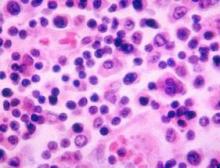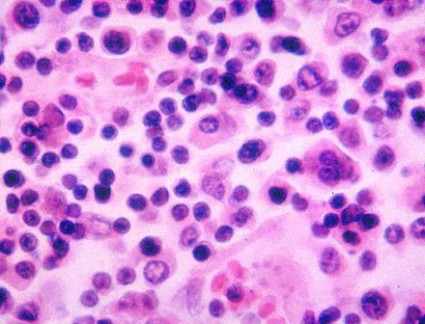User login
SAN DIEGO – Typhoid vaccines continue to be 84% effective and should be given to patients who are traveling to typhoid endemic areas, based on the results of a survey of case reports to the Centers for Disease Control and Prevention.
Patients also need to be reminded to follow safe food and water precautions, since the vaccine is not 100% effective, Anna Newton, M.P.H., said in an interview during a poster session during IDWeek.
Ms. Newton and her colleagues analyzed the National Typhoid and Paratyphoid Fever Surveillance database from 2008-2010. Managed by Ms. Newton, this database contains demographic information, travel history, and typhoid vaccination status in the 5 years before illness onset in cases of typhoid fever and paratyphoid fever reported to the CDC by state and local health officials. The researchers estimated vaccine effectiveness by comparing vaccination rates in travelers who became infected.
From 2008 to 2010, the CDC received data regarding 977 travelers with typhoid fever and 241 with paratyphoid fever. Vaccination status was available in 65% of travelers with typhoid fever and 50% of those with paratyphoid fever. From this data the researchers estimated the vaccine effectiveness to be 84%, "which is on par with what we expected to find," Ms. Newton said. "The vaccine is moderately effective."
Only 6% of patients with typhoid fever and 29% with paratyphoid fever reported having received a typhoid vaccine within the past 5 years. Asia was the most common region of travel for patients with typhoid fever (94%) and paratyphoid fever (99%), with India being the most commonly reported destination country (57% and 67%, respectively).
Two typhoid vaccines are currently available in the United States: a live attenuated oral vaccine (Vivotif, Crucell/Berna) and an intramuscular polysaccharide vaccine (Typhim Vi, Sanofi Pasteur). Neither is licensed for use in children younger than 2 years of age. Prior to the current analysis little had been known about the effectiveness of either vaccine in U.S. travelers, said Ms. Newton, a surveillance epidemiologist with the Enteric Diseases Epidemiology Branch of the Centers for Disease Control and Prevention, Atlanta.
Ms. Newton acknowledged certain limitations of the study, including the fact that many patients were excluded due to unknown vaccination status. "Improvement in completeness of reporting vaccination status and type of vaccine received could enhance the reliability of these estimates and could facilitate estimation of vaccine effectiveness for each vaccine," the researchers concluded in their abstract.
IDWEEK was the combined annual meetings of the Infectious Diseases Society of America, the Society for Healthcare Epidemiology of America, the HIV Medicine Association, and the Pediatric Infectious Diseases Society. Ms. Newton said that she had no relevant financial conflicts to disclose.
SAN DIEGO – Typhoid vaccines continue to be 84% effective and should be given to patients who are traveling to typhoid endemic areas, based on the results of a survey of case reports to the Centers for Disease Control and Prevention.
Patients also need to be reminded to follow safe food and water precautions, since the vaccine is not 100% effective, Anna Newton, M.P.H., said in an interview during a poster session during IDWeek.
Ms. Newton and her colleagues analyzed the National Typhoid and Paratyphoid Fever Surveillance database from 2008-2010. Managed by Ms. Newton, this database contains demographic information, travel history, and typhoid vaccination status in the 5 years before illness onset in cases of typhoid fever and paratyphoid fever reported to the CDC by state and local health officials. The researchers estimated vaccine effectiveness by comparing vaccination rates in travelers who became infected.
From 2008 to 2010, the CDC received data regarding 977 travelers with typhoid fever and 241 with paratyphoid fever. Vaccination status was available in 65% of travelers with typhoid fever and 50% of those with paratyphoid fever. From this data the researchers estimated the vaccine effectiveness to be 84%, "which is on par with what we expected to find," Ms. Newton said. "The vaccine is moderately effective."
Only 6% of patients with typhoid fever and 29% with paratyphoid fever reported having received a typhoid vaccine within the past 5 years. Asia was the most common region of travel for patients with typhoid fever (94%) and paratyphoid fever (99%), with India being the most commonly reported destination country (57% and 67%, respectively).
Two typhoid vaccines are currently available in the United States: a live attenuated oral vaccine (Vivotif, Crucell/Berna) and an intramuscular polysaccharide vaccine (Typhim Vi, Sanofi Pasteur). Neither is licensed for use in children younger than 2 years of age. Prior to the current analysis little had been known about the effectiveness of either vaccine in U.S. travelers, said Ms. Newton, a surveillance epidemiologist with the Enteric Diseases Epidemiology Branch of the Centers for Disease Control and Prevention, Atlanta.
Ms. Newton acknowledged certain limitations of the study, including the fact that many patients were excluded due to unknown vaccination status. "Improvement in completeness of reporting vaccination status and type of vaccine received could enhance the reliability of these estimates and could facilitate estimation of vaccine effectiveness for each vaccine," the researchers concluded in their abstract.
IDWEEK was the combined annual meetings of the Infectious Diseases Society of America, the Society for Healthcare Epidemiology of America, the HIV Medicine Association, and the Pediatric Infectious Diseases Society. Ms. Newton said that she had no relevant financial conflicts to disclose.
SAN DIEGO – Typhoid vaccines continue to be 84% effective and should be given to patients who are traveling to typhoid endemic areas, based on the results of a survey of case reports to the Centers for Disease Control and Prevention.
Patients also need to be reminded to follow safe food and water precautions, since the vaccine is not 100% effective, Anna Newton, M.P.H., said in an interview during a poster session during IDWeek.
Ms. Newton and her colleagues analyzed the National Typhoid and Paratyphoid Fever Surveillance database from 2008-2010. Managed by Ms. Newton, this database contains demographic information, travel history, and typhoid vaccination status in the 5 years before illness onset in cases of typhoid fever and paratyphoid fever reported to the CDC by state and local health officials. The researchers estimated vaccine effectiveness by comparing vaccination rates in travelers who became infected.
From 2008 to 2010, the CDC received data regarding 977 travelers with typhoid fever and 241 with paratyphoid fever. Vaccination status was available in 65% of travelers with typhoid fever and 50% of those with paratyphoid fever. From this data the researchers estimated the vaccine effectiveness to be 84%, "which is on par with what we expected to find," Ms. Newton said. "The vaccine is moderately effective."
Only 6% of patients with typhoid fever and 29% with paratyphoid fever reported having received a typhoid vaccine within the past 5 years. Asia was the most common region of travel for patients with typhoid fever (94%) and paratyphoid fever (99%), with India being the most commonly reported destination country (57% and 67%, respectively).
Two typhoid vaccines are currently available in the United States: a live attenuated oral vaccine (Vivotif, Crucell/Berna) and an intramuscular polysaccharide vaccine (Typhim Vi, Sanofi Pasteur). Neither is licensed for use in children younger than 2 years of age. Prior to the current analysis little had been known about the effectiveness of either vaccine in U.S. travelers, said Ms. Newton, a surveillance epidemiologist with the Enteric Diseases Epidemiology Branch of the Centers for Disease Control and Prevention, Atlanta.
Ms. Newton acknowledged certain limitations of the study, including the fact that many patients were excluded due to unknown vaccination status. "Improvement in completeness of reporting vaccination status and type of vaccine received could enhance the reliability of these estimates and could facilitate estimation of vaccine effectiveness for each vaccine," the researchers concluded in their abstract.
IDWEEK was the combined annual meetings of the Infectious Diseases Society of America, the Society for Healthcare Epidemiology of America, the HIV Medicine Association, and the Pediatric Infectious Diseases Society. Ms. Newton said that she had no relevant financial conflicts to disclose.
AT IDWEEK
Major Finding: The estimated effectiveness of typhoid vaccines in travelers stands at 84%.
Data Source: A study of 649 cases of typhoid fever and 122 cases of paratyphoid fever reported to the National Typhoid and Paratyphoid Fever Surveillance System between 2008 and 2010.
Disclosures: The study was conducted by the Centers for Disease Control and Prevention.


